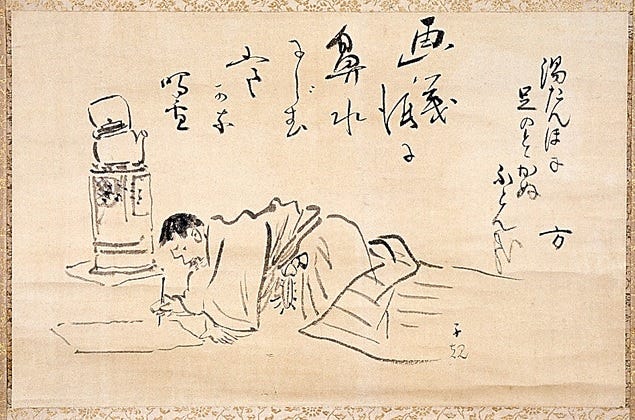Shiki's Window: A Call for Submissions
Accepting haiku (5/7/5), haibun, haiga and sequences until November 9th
木をつみて夜の明やすき小窓かな ki o tsumite yo no akeyasuki komado kana A pruned branch And dawn comes easily To my little window (tr. by Hart Larrabee)
Masaoka Shiki (正岡 子規, October 14, 1867 – September 19, 1902), pen-name of Masaoka Noboru (正岡 升), was a Japanese poet, author, and literary critic in Meiji period Japan. Shiki is considered a major figure in the development of modern haiku poetry, credited with writing close to 20,000 stanzas during his short life. One of Shiki’s most notable contributions was defining the concept of shasei, or the sketch-from-life poem, as a guiding principle for his haiku. Inspired by modern Western painting styles and concerned that Japanese poetry may be stagnating, Shiki stressed that scenes from nature should be observed and depicted directly, rather than relying on idealizations or abstraction, to more directly capture the essence of the moment. Bedridden for much of his short life because of his illness, and his point of view for observing nature severely limited by what he could see through a small window from his tatami mat, Shiki’s razor-sharp focus allowed him to create poems which depicted scenes of interest in almost hyperreal detail. His poems demonstrate how pushing against limitations can catalyze a fresh perspective on everyday subjects. There’s also something inherent within the process of closely observing nature from a fixed point in space which allows the poet to engage with the passing of time, and with the reality of impermanence, including that of one’s own life, on a deeper level.
餘命いくばくかある夜短し yomei ikubaku ka aru yo mijikashi how much longer is my life? a brief night… (tr. by Janine Beichman, U. of Virginia)
When we first thought about Shiki’s Window as a possible theme for a Haiku Pause issue, we were thinking of Shiki in his illness lying on his tatami mat craning his neck to look out the window to get ideas for his haiku. And thinking about how he loved persimmons but couldn’t eat so many because they made him feel even more ill. We were thinking of how limitations in life, such as an experience of illness can make us feel connected to Shiki’s process and experience, and that we can learn from him how we can still write poetry and have beautiful moments despite the limitations of illnesses and other life challenges. And then too we realize that there is so much to write about and think about for anyone who takes a moment to gaze out their window and really look. We can in fact simply look out our own window and create a haiku right there, inspired by what we see and experience and remember, in that very moment.
病牀の我に露ちる思ひあり byōshō no ware ni tsuyu chiru omoi ari I thought I felt a dewdrop on me as I lay in bed (tr. by Janine Beichman, U. of Virginia)
There is the idea of a window as both a limitation – because one is behind the window and the world is out there – and, alternatively, a window as an opening to larger life, to the whole world, no matter the state of that world in a given moment. We can think not only about limitations, but also about the possibilities (and hope) that might arise once we open a window. Then there are our very own eyes, windows to the soul – and the places our own eyes, our own souls can take us – all these ways of looking at a window can inspire us as we create haiku, haiga and haibun on this theme: Shiki’s Window.
ちる花にもつるゝ鳥の翼かな chiru hana ni motsururu tori no tsubasa kana entangled with the scattering cherry blossoms— the wings of birds! (tr. by Janine Beichman, U. of Virginia)
We invite you to create and submit individual 5/7/5 haiku (up to 5), haiku sequences (up to 2 sequences, containing up to 5 haiku each), a haibun, or 1-3 haiga responding very widely to the theme of Shiki’s Window. Submissions will be open until November 9th. Please send your submission directly to sketchfromlife@gmail.com.
Our guest editor for this issue will be Valerie Rosenfeld, whose own sketch-from-life haiku we find so inspiring.
We look forward to reading your work!
—The Editors.
PS: Some additional resources on Shiki and the origins and influence of shasei poetry can be found at the Haiku Foundation and on the Upaya website.



Thanks for this glimpse through the window on Shiki's life and work.
This is an enticing perspective, with the spirit of such a prolific, life-loving poet and artist.